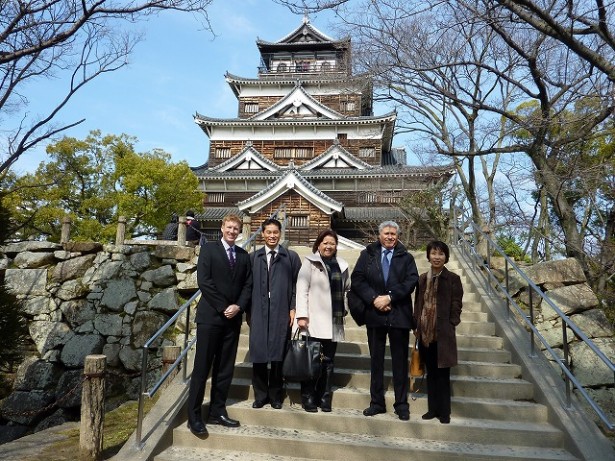Over the Years
Home > Over the Years > Over the Fiscal Years (2010 APR - 2020 MAR) > Six Doctors Invited from Brazil and Other Countries for Training
Six Doctors Invited from Brazil and Other Countries for Training
HICARE invited six doctors from Brazil, USA, Algeria, and Korea for training on health care of the radiation-exposed.
Names and Titles of Trainees:
February 4 to 28, 2014
1. Claudio Lyoiti Hashimoto
Assistant Doctor (Gastroenterology), Hospital Santa Cruz (Brazil)
2. Martha Megumi Kumagai
Chief of Department of Ophthalmology, Hospital Sugisawa (Brazil)
February 17 to 21, 2014
3. Paul J. Eakin
Pediatric Emergency Physician, Assistant Professor of Pediatrics
University of Hawai‘i John A. Burns School of Medicine (USA)
4. Boudjema Mansouri
Professor & Head of Department (Radiology), University Hospital of Bab el Oued (Algeria)
*Introduced by the International Atomic Energy Agency (IAEA)
5. Jinsil Seong
Professor in Department of Radiation Oncology, Yonsei University Medical Center (Korea)
*Introduced by the International Atomic Energy Agency (IAEA)
February 21 to March 5, 2014
6. Adley Rogerio Martos Haiashi
Attending Physician, Team of Geriatrics, Hospital Nipo Brasileiro (Brazil)
Training Organizations (in order of visits):
【Short-term Program】for Trainees 1 to 5
Hiroshima University Hospital (Advanced Emergency and Critical Care Center)
Hiroshima Red Cross Hospital & Atomic-bomb Survivors Hospital
Hiroshima University Research Institute for Radiation Biology and Medicine (Outline)
Hiroshima Atomic Bomb Casualty Council
Radiation Effects Research Foundation
Kurakake Nozomi-en (A-bomb survivors nursing home)
Hiroshima Peace Memorial Museum, etc.
【Mid to Long-term Program】 for Trainees 1, 2, and 6
The 4th International Symposium of Hiroshima University Research Institute for Radiation Biology and Medicine
Hiroshima University Research Institute for Radiation Biology and Medicine (Details of research fields)
Hiroshima University Hospital (Department of Endoscopy) - Trainee 1
Hiroshima University Hospital (Department of Ophthalmology) - Trainee 2
Hiroshima University Hospital (Department of Nephrology) - Trainee 6
Training Course:
Diagnosis of radiation disorders
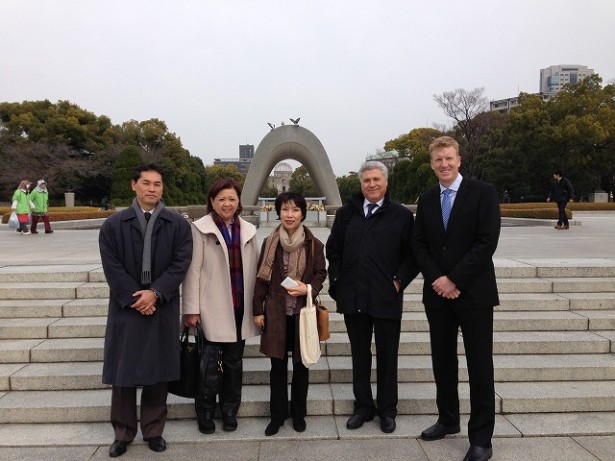
At the cenotaph
From left, Doctors Hashimoto, Kumagai, Seong, Mansouri, and Eakin

With Professor Koichi Tanigawa (far left), Director of Advanced Emergency and Critical Care Center, Hiroshima University Hospital
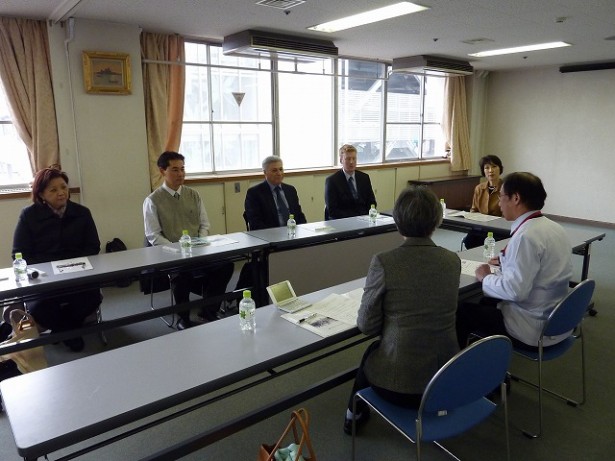
In the lecture of Dr. Kenichi Arita (far right), Director of Department of Respiratory Disease of Hiroshima Red Cross Hospital & Atomic-bomb Survivors Hospital

With Dr. Toshiya Inaba (far left), Director of Hiroshima University Research Institute for Radiation Biology and Medicine
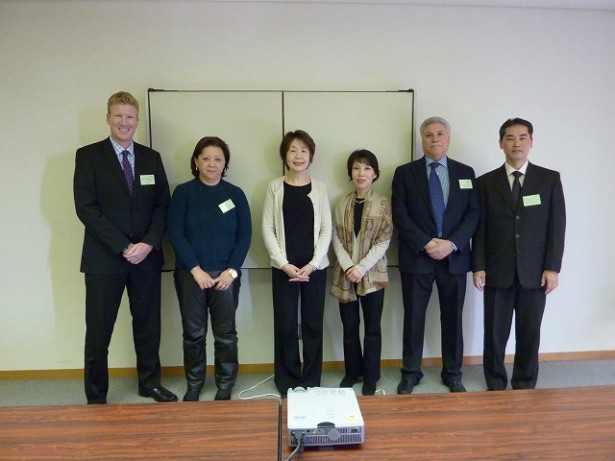
With Dr. Saeko Fujiwara (3rd from left), Director of Health Management & Promotion Center, Hiroshima Atomic Bomb Casualty Council
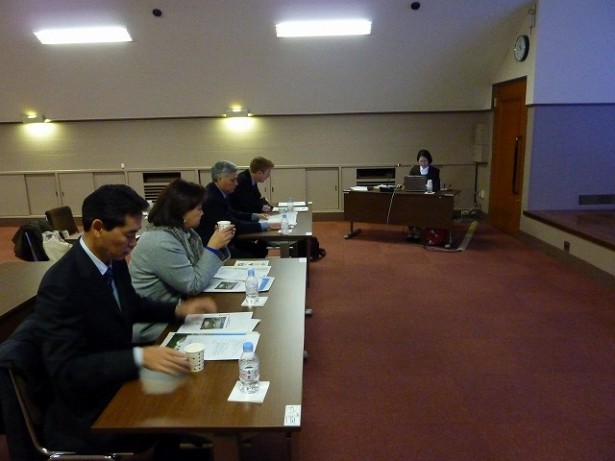
In the lecture at Radiation Effects Research Foundation
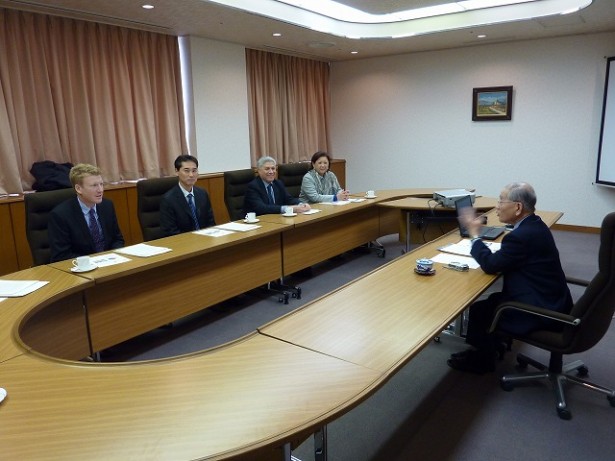
With Dr. Nanao Kamada (far right), Board Chairman of Hiroshima A-Bomb Survivors Relief Foundation
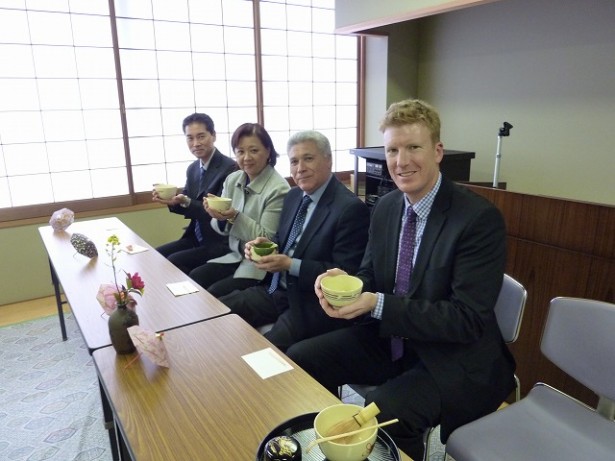
Enjoying tea ceremony at Kurakake Nozomi-en
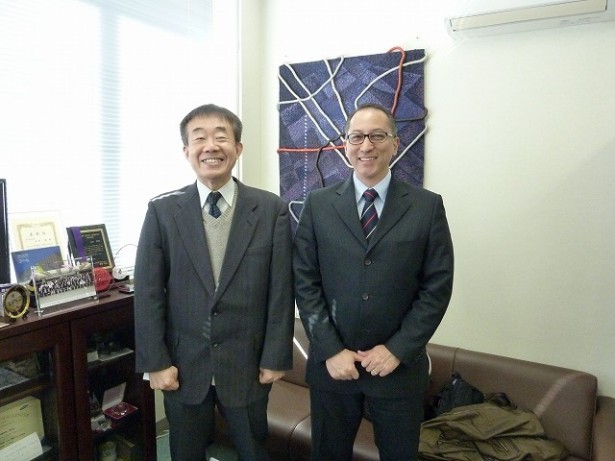
Professor Yasushi Nagata (left) of Department of Radiation Oncology, Hiroshima University Hospital and Dr. Haiashi

With Professor Satoshi Tashiro (far left), Hiroshima University Research Institute for Radiation Biology and Medicine
Feedback:
-Without doubt, the opportunity to meet and speak with survivors of first and second generation of the atomic bomb, and for the other side, watch the planning, commitment and some of efforts of the national government, municipality (Hiroshima prefecture, university and hospitals in supporting survivors is exceptional indeed.
After all difficulties of the post war, is also extraordinary the nation progress and rebirth after a relatively short period of 70 years.
In addition to applying the knowledge (which I obtained at Hiroshima University Hospital) for improved diagnosis and treatment of every cancer of digestive tract, I’ll try to apply the method of information gathering, division of labor and responsibilities in a similar way to that observed in Japanese department of endoscopy.
-I learned a lot about the effects of radiation on human body and about how A-bomb survivors have lived for 68 years after bombing.
I stayed in the Ophthalmology Department of Hiroshima University Hospital, and it was very pleasant. The chief of the department was very friendly and kind.
The city was very nice and people were very kind to me.
-This training was very instructive for me because I could have knowledge about what happened in Hiroshima after atomic bomb explosion and suffering caused. The technical knowledge about the heath impact were great but what was most striking were the experiences I’ve had in the places visited. I was thrilled with the instant death and what happened after. The injuries, illness and impact in the short, medium and long term even today for the people of Hiroshima.
I will use the knowledge gained to help victims of the atomic bomb in Brazil to minimize the physical and psychological suffering. I’ll look for information about survivors’ aid the assistance for them. I’ll be a multiplier of the information acquired in HICARE program to promote awareness for the prevention of tragedies linked to nuclear radiation and peace for humanity.
-This morning I took a walk in the Peace Memorial Park. Many workers were walking to their workplaces in the city. I noticed two different people stop and bow at the cenotaph for the A-bomb victims. This had a very deep impact on me. I realized that for the citizens of Hiroshima, remembering the Atomic bomb is very real in their everyday lives.
At Hiroshima University, I found out that their first Guiding Principles is “Pursuit of Peace”. This is very powerful. I doubt that any U.S. University has pursuit of peace as a guiding principle Through HICARE I have realized how important peace is in our world today. I also witnessed the deep compassion of doctors’, such as Dr. Arita at the Red Cross Hospital. His compassion as a 2nd generation A-bomb survivors truly touched me.
I will definitely share what I have learned to my division of pediatric emergency medicine in terms of preparing for possible radiation exposure. I will also be very diligent in preventing ionizing radiation exposure in pediatric patients. I will treat my patients with the love and compassion I witnessed from the Japanese doctors here in Hiroshima.
-The program of the meeting included all the topics necessary for the comprehension of the nuclear effects.
In 1960 in Algeria, an A-bomb was tested by the French military (Reggane located in the south). The knowledge of Hiroshima (Japan) and HICARE in the field is very interesting and could help us to manage the file of the nuclear effects.
-A diverse spectrum of key persons participated as speakers and demonstrators involving not only administrative officers (a head of administrative office in Hiroshinma City Hall, acting personnel in HICARE headquarter in Hiroshima prefectural government) but also professionals in Hiroshima University, Hiroshima Red Cross Hospital, and A-bomb Casualty Council. Also chances were allowed to see core facilities. These whole content was satisfactory to the attendee in HICARE who have been interested and wished to learn.
Since I am working as a professor in the university, this learning will be transferred to education for students and residents as well.
Through my column about radiation which I’m regularly writing, I’ll try to enhance public awareness about atomic accident and global action for peace.
I am conducting radiobiology research with government grant. I’ll be more focused on radiation effect on human and hope to collaborate with Hiroshima University in the future.
